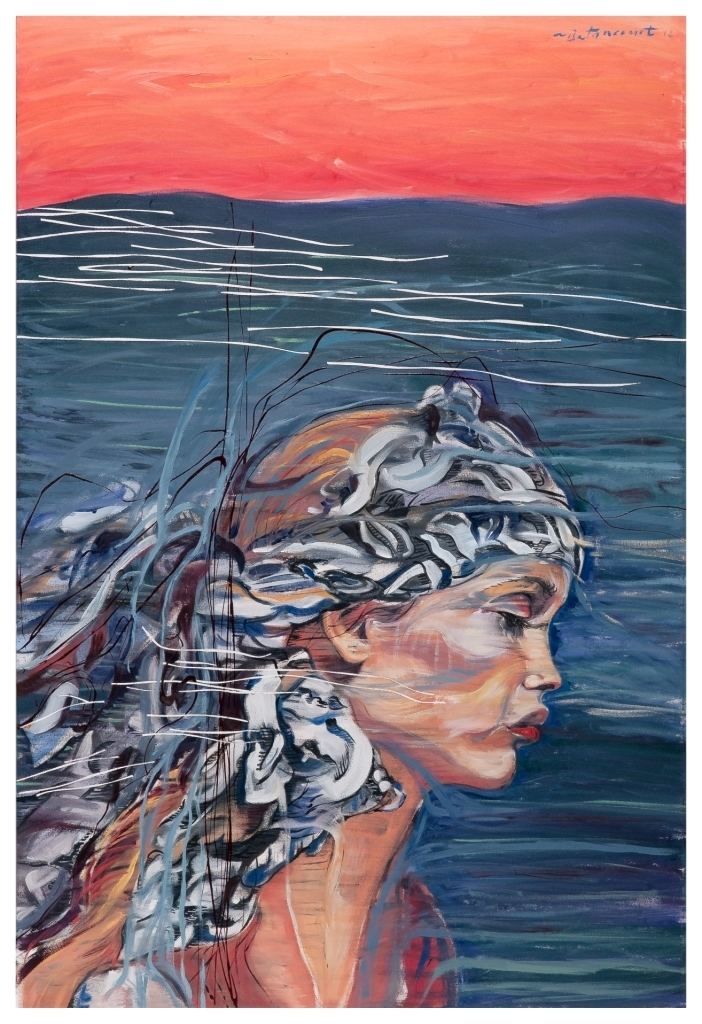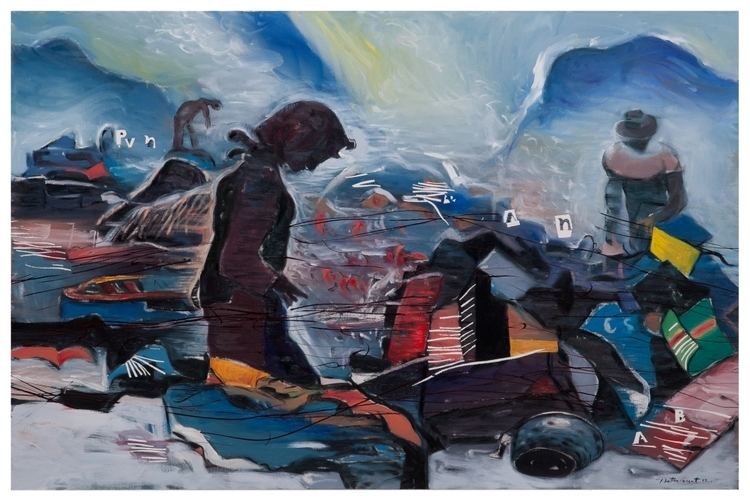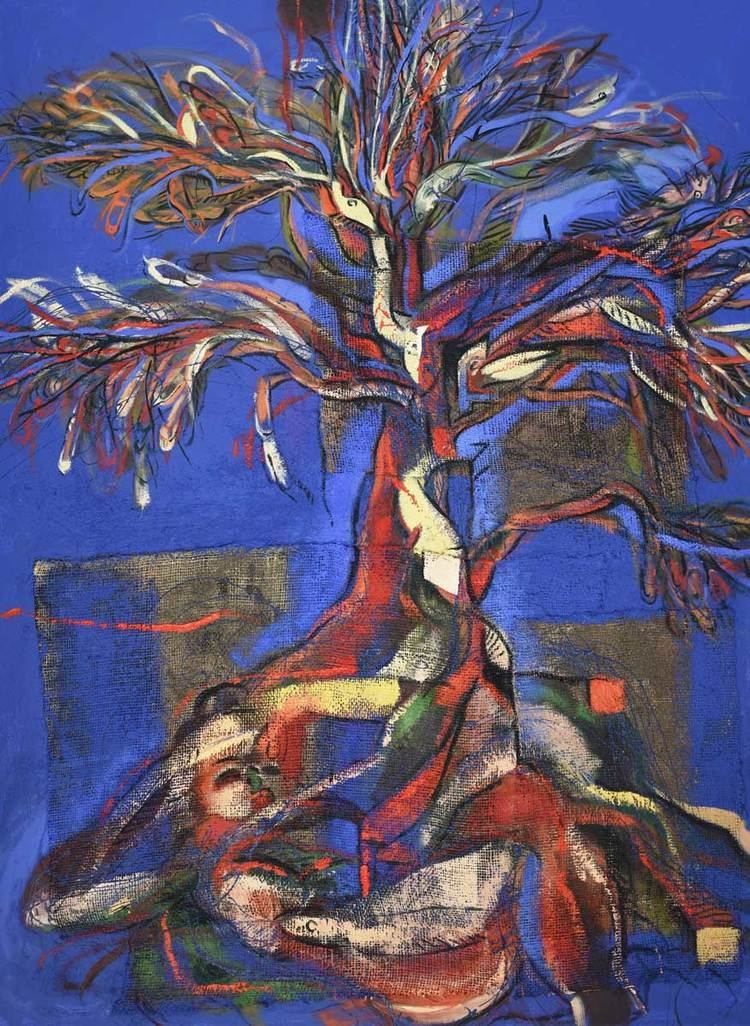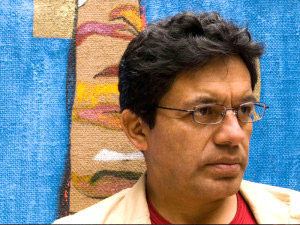Nationality Ecuadorian Known for Contemporary Art | Name Miguel Betancourt | |
 | ||
Website www.miguelbetancourt.com Education Pontificia Universidad Catolica del Ecuador | ||
Miguel betancourt im genes a trasluz
Miguel Betancourt (born January 5, 1958) is an Ecuadorian contemporary artist living in Quito, Ecuador. He was formed as an artist in Ecuador, the United States, and the United Kingdom. His paintings are a fusion of local cultural motives and colors, and Western artistic influence.
Contents
- Miguel betancourt im genes a trasluz
- Video blog uam i jos miguel betancourt biolog a de la reproducci n y gen tica
- Life
- Career Highlights
- Art
- Main Exhibitions
- References

Video blog uam i jos miguel betancourt biolog a de la reproducci n y gen tica
Life

Born in Quito, Ecuador in 1958, Betancourt grew up in the outskirts of the city (Cumbayá). His talent drew attention early in his teenager years, and he was encouraged to attend art classes in Quito. Prominent Ecuadorian artist, Oswaldo Moreno, became his tutor, friend and artistic guidance. Betancourt claims to have discovered his artistic vocation early. "When my mother fell ill and the five of us were left alone, we were afraid we would lose her. My childhood was full of loneliness, and perhaps that's why I began to paint. It was a recreational activity that would free me from the anguish of poverty and the absence of my mother... my art began in childhood. It was a refuge; I didn't imagine it would become my profession."

His artistic talent earned him a scholarship to study at the Milwaukee Art Center, United States, for a year. Upon his return to Ecuador, he enrolled in university to study Pedagogy and Literature at the Pontificia Universidad Católica del Ecuador. In 1988, he was invited by the Department of State of the USA to a Cultural Tour. In the same year, the British Council awarded him a scholarship to study a postgraduate art degree at the Slade School of Fine Art at the University College London. During his time in London, Betancourt befriended British artist John Hoyland.

Betancourt has travelled broadly through the promotion of his artwork, but resides permanently in the valley of Cumbayá (Quito, Ecuador). Besides his painting, he is devoted to growing tropical plants, pampering his several dogs and nurturing a healthy and colorful ecosystem for plant and animal life in his land.
Career Highlights

After returning to Quito from London, he continued to strengthen his presence in Europe with a traveling exhibition through England, the Netherlands and Austria. In 1993, he was selected to represent his country at the XLV. Venice Biennale, Italy and then received the Pollock-Krasner Award conferred by the Pollock-Krasner Foundation in New York City, United States. Meanwhile, his art was exhibited in museums and exhibitions, and found part in private collections in Europe and Latin America, including the art collections of the United Nations offices in Vienna and in Geneva (specifically in UNAIDS). In 2000, the University of Western Sydney invited Betancourt to lecture on Ecuadorian art and exhibit his artwork at the Canberra Museum and Gallery. Between 2001 and 2003, his paintings went on itinerant shows through Central America. Highlights in the recent past include participation in Visual Trends in Ecuador´s Contemporary Art organized by the Corporación Andina de Fomento in Caracas, Venezuela (2004); participation as Invitee of Honor to the V. International Art Biennial SIART in La Paz, Bolivia (2007), and in The Night of the Museums in Buenos Aires, Argentina (2009). He was appointed to be the Ecuador coordinator of Luciano Benetton's (Benetton family) Ojo Latino Project (Milan 2008) – a book publication of Latin American contemporary art selected by Benetton. In this book, critic Manuel Basoalto expresses that Betancourt’s art works "present great coherence, where the chromatic range and underlying language connects us to what could be a certain imaginary of Latin America".

Since 2008 his work has been exhibited with the Benetton Foundation, in group shows in Santiago, Treviso, Milan and Mongolia. At the beginning of 2011, Betancourt participated in the "Exhibition of Latin American and Caribbean Artists" in the Tokyo City Hall, organized by the embassies of the Americas. In July 2012, he participated in a collective exhibition "Ecuador Beyond Concepts" at the gallery of the Cervantes Institute in Rome. Then, in September 2013, the Gallery Bandi-Trazos invited him to be part of the Latin-American Pavilion in the International Art Fair, in the Beijing Exhibition Center. More recently, in 2014 he was part of a collective exhibition "Ecuador in Focus" (along 2 other Ecuadorian artists), at the OPEC Fund for International Development headquarters in Vienna. In December of the same year, Betancourt displayed an innovative show "Translucent Imagery" at the French Alliance in Quito, which was conformed of a set of double-sided watercolors encapsulated in glass, and hung as mobiles or mounted on metallic bases. The show received wide public and critical acclaim. Betancourt continues to be involved in various projects and exhibitions in Ecuador and internationally. Miguel Betancourt is a founding member of movement Art Résilience created in Paris in 2014, with headquarters in the Bateau-Lavoir, Paris.
Art
Miguel Betancourt grew up in a rural environment, in one of the outskirt valleys of Quito. His earliest artistic manifestations were inspired by the surrounding landscapes. Colorful and abundant vegetation, trees, the Andean mountains and clear blue skies turned into his constant motifs throughout his artistic career. In his beginnings, Betancourt explored with watercolors and became interested in pre-Columbian symbols, notably the Quipus – the numerical system designed by the Incas – and the cityscape of Quito (see Gallo de la Catedral).
During his one-year experience in England and travels through Europe, he was attracted to Gothic cathedrals, to their elongated arches and the contrasting light of stained glasses, which left a long lasting impression and a strong appeal for architecture. Likewise, his live exposure to Western art, including paintings by Van Gogh, Miró, Picasso, F. Bacon, and its artistic diversity encouraged him to move towards greater dimensions and mixed media, including oil painting and acrylic. Art critic William Jeffett, refers to Betancourt's artistic strategy as "one directed inward as much as outward, and through the act of painting he seeks to interrogate his own identity as much as he seeks to remake painting as a vehicle for imagining an Andean sensibility".
In the early 1990, he returned to Ecuador to combine Ecuadorian and European motifs, through a mix of tropical vegetation and gothic European architecture in large canvases with mixed media. In his exhibition Selva Ojival in 1992-93 (see Ojivas de la Selva) the tree, one of the central motifs of this series, integrates the culture constructions of the Gothic. His interest in more diverse architecture flourished further – he took inspiration from pre-Columbian temples, colonial churches and neighborhoods, and foreign cities that he visited on cultural tours – among them Jerusalem. In the 2000s, Betancourt adopted new media, techniques and styles; whilst continuing to work on paper and canvas, he adopted a novel and well appreciated support, the cànamo (hemp). On hemp, he impregnated abstract and architectural trees – creating a fusion of trees, plants, geometrical shapes and city views – often accompanied by abundant texture, attained through the incorporation of various materials such as wood, branches, and volcanic ash (see Árbol de letras). The use of hemp and volcanic ash helps Betancourt establish relationships between nature and culture, past and present, in order to reveal the effect of the passage of time on the material world. Furthermore, this cloth reveals the aging process due to its reutilization and the grayish patina, giving the hemp and his paintings a timeless aspect.
In 2003-2004, he introduced a fresh artistic style, based on a combination of collage, blue drawing and dripping that differed from his previous art work. For his new artistic proposal in 2003, made up of a series of blue drawings over kraft paper, he employed wooden branches to draw human bodies and faces (see Naipe). In the following years, Betancourt pursued his interest on human faces, recreating strong, colorful portraits through a fusion of cubist and expressionist styles (see Flora y Fauna en Cabeza Femenina). In 2008, he, among other Ecuadorian artists, participated in the Ispirato Corpo project in the Cuenca Biennial of Ecuador, where he impregnated a mix of abstract vegetation forms, drawing and dripping on haute couture dresses. In the same year, he participated in an urban art project called Toros de Colores (Colored Bulls), in which several artists painted on bulls made out of glass fiber that were subsequently exhibited in public spaces throughout the city of Quito. In 2011, he was invited again to participate in the project Quito Jardin de Quindes (Quito Garden of Hummingbirds), where a group of prominent Ecuadorian artists painted on large scale ceramic hummingbirds to honour Quito's cultural symbol [the hummingbird]. In November 2011, he presented an individual retrospective Colores y Texturas (Colors and Textures). This large exhibition, shown in the Casa de la Cultura Ecuatoriana, compiled approximately 100 paintings from the past 25 years of his artistic career.
His latest artistic proposal, presented in December 2014 at the French Alliance in Quito, featured a set of innovative double-sided watercolors encapsulated in glass, and hung as mobiles or mounted on metallic bases. Betancourt designed free standing metal frames to support very thin sheets of rice paper, fixed back to back and compressed between two plates of glass, as if they were sculptures. These sheets faced outward and could be viewed from either side. His purpose was to allow the surrounding light play a significant role in illuminating these works. Inspired again by the stained glasses of medieval churches, Betancourt explains that he seeks "to capture the impact of light for the purpose of giving shape to images that can be observed in a particular time and space; for instance, if these renderings are placed next to a window, they will be viewed quite differently depending on the time of day... the silky images interact with each other as they infuse the drawings and tonalities to provoke new images or successive mutations. In this way, the implied forms take on an air of mystery or become beautiful and seductive". This exhibition, entitled "Translucent Imagery", was widely praised by critics, public and the media. It was accompanied by a book-catalogue with the exhibition’s name, featuring more than 80 watercolors produced throughout Betancourt’s artistic career.
